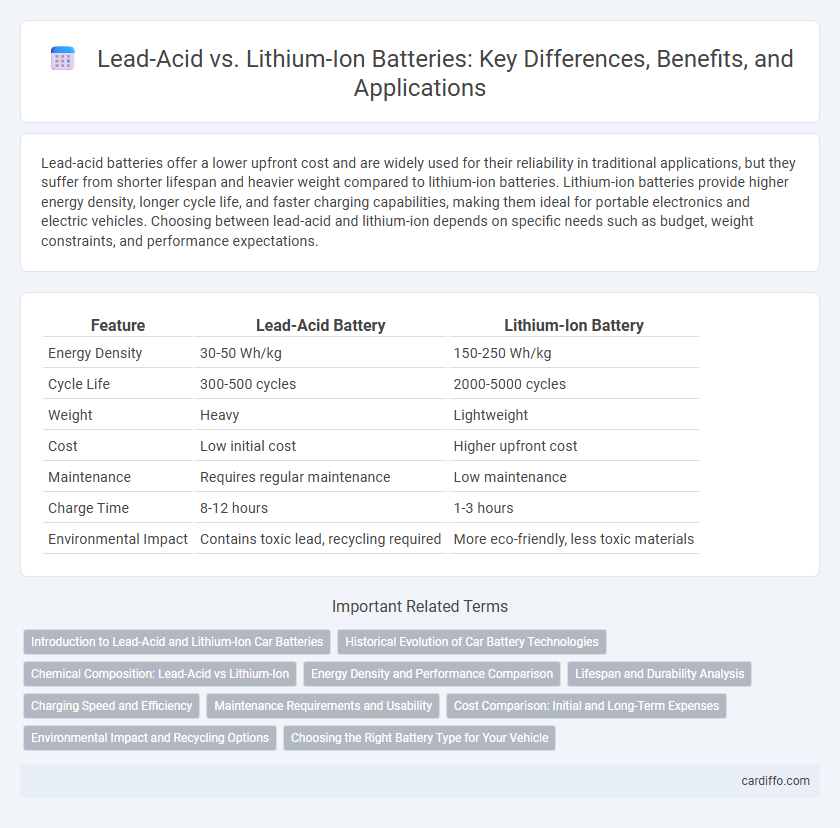Lead-acid batteries offer a lower upfront cost and are widely used for their reliability in traditional applications, but they suffer from shorter lifespan and heavier weight compared to lithium-ion batteries. Lithium-ion batteries provide higher energy density, longer cycle life, and faster charging capabilities, making them ideal for portable electronics and electric vehicles. Choosing between lead-acid and lithium-ion depends on specific needs such as budget, weight constraints, and performance expectations.
Table of Comparison
| Feature | Lead-Acid Battery | Lithium-Ion Battery |
|---|---|---|
| Energy Density | 30-50 Wh/kg | 150-250 Wh/kg |
| Cycle Life | 300-500 cycles | 2000-5000 cycles |
| Weight | Heavy | Lightweight |
| Cost | Low initial cost | Higher upfront cost |
| Maintenance | Requires regular maintenance | Low maintenance |
| Charge Time | 8-12 hours | 1-3 hours |
| Environmental Impact | Contains toxic lead, recycling required | More eco-friendly, less toxic materials |
Introduction to Lead-Acid and Lithium-Ion Car Batteries
Lead-acid car batteries are traditionally used in vehicles due to their reliability, low cost, and ability to deliver high surge currents for engine starting. Lithium-ion car batteries offer higher energy density, longer cycle life, and lighter weight, making them ideal for electric and hybrid vehicles. Both battery types play crucial roles in automotive applications, with lead-acid batteries dominating conventional cars and lithium-ion gaining prominence in modern electric mobility.
Historical Evolution of Car Battery Technologies
Lead-acid batteries, invented in the mid-19th century, dominated early automotive applications due to their low cost and reliable energy storage despite heavy weight and limited cycle life. The development of lithium-ion technology in the 1990s introduced a lighter, more energy-dense alternative with longer lifespan and faster charging capabilities, revolutionizing electric vehicles and portable electronics. Continuous advancements in lithium-ion chemistry and manufacturing have accelerated the shift from traditional lead-acid batteries to more sustainable and efficient energy storage solutions in modern transportation.
Chemical Composition: Lead-Acid vs Lithium-Ion
Lead-acid batteries feature a chemical composition of lead dioxide (PbO2) cathode, sponge lead (Pb) anode, and sulfuric acid (H2SO4) electrolyte, enabling energy storage through reversible lead sulfate formation. Lithium-ion batteries utilize lithium cobalt oxide (LiCoO2) or other lithium metal oxides as cathodes, carbon-based anodes, and organic electrolytes containing lithium salts like LiPF6, facilitating high energy density via lithium-ion intercalation. The distinct chemical compositions result in different voltage outputs, energy densities, and cycle lives, with lithium-ion chemistry offering denser, lighter, and longer-lasting energy storage compared to traditional lead-acid systems.
Energy Density and Performance Comparison
Lithium-ion batteries typically offer an energy density of 150-250 Wh/kg, significantly higher than lead-acid batteries, which range around 30-50 Wh/kg. This higher energy density translates to longer battery life and more efficient performance in portable and electric vehicle applications. Lead-acid batteries, while heavier and bulkier, provide reliable energy delivery for stationary or low-demand uses but fall short in energy efficiency compared to lithium-ion technology.
Lifespan and Durability Analysis
Lead-acid batteries typically offer a lifespan of 3 to 5 years with moderate cycle durability, often suffering capacity degradation from sulfation and corrosion. Lithium-ion batteries provide superior lifespan ranging from 8 to 15 years, maintaining higher cycle stability due to advanced electrode materials and improved electrolyte formulations. Durability analysis highlights lithium-ion's resilience to deep discharge and temperature variations, making it more reliable for long-term energy storage applications.
Charging Speed and Efficiency
Lithium-ion batteries charge significantly faster than lead-acid batteries, typically reaching full charge in 1 to 3 hours compared to 8 to 16 hours for lead-acid types. Lithium-ion technology offers higher energy efficiency, with charging efficiencies around 90-95%, whereas lead-acid batteries range between 70-85%. This results in reduced energy loss and shorter downtime, making lithium-ion batteries more suitable for applications requiring quick recharge cycles and efficient power management.
Maintenance Requirements and Usability
Lead-acid batteries require regular maintenance including water refilling, equalizing charges, and terminal cleaning to prevent sulfation and corrosion, making them less user-friendly for everyday users. Lithium-ion batteries offer a maintenance-free experience with built-in battery management systems that optimize charge cycles, enhance safety, and extend lifespan. The usability of lithium-ion batteries is superior due to their lightweight design, faster charging capabilities, and higher energy density, making them ideal for portable electronics and electric vehicles.
Cost Comparison: Initial and Long-Term Expenses
Lead-acid batteries have a lower initial cost but higher long-term expenses due to frequent replacements and maintenance. Lithium-ion batteries feature a higher upfront price but offer superior lifespan and efficiency, reducing overall costs over time. Cost analysis should consider total cost of ownership, including energy density, cycle life, and maintenance requirements.
Environmental Impact and Recycling Options
Lead-acid batteries have a higher environmental impact due to their toxic lead content and corrosive sulfuric acid, which pose significant recycling challenges and require specialized facilities for safe disposal. In contrast, lithium-ion batteries contain less hazardous materials and offer more efficient recycling options, recovering valuable metals like lithium, cobalt, and nickel, thereby reducing landfill waste and resource extraction. However, lithium-ion recycling processes are still developing and can be energy-intensive, necessitating further advancements to fully minimize their environmental footprint.
Choosing the Right Battery Type for Your Vehicle
Lead-acid batteries remain a cost-effective choice for traditional vehicles due to their reliable starting power and ease of recycling, while lithium-ion batteries offer superior energy density, longer lifespan, and faster charging suitable for electric and hybrid vehicles. Consider vehicle type, usage patterns, budget, and environmental impact when selecting between lead-acid and lithium-ion batteries. Evaluating performance metrics such as cycle life, maintenance requirements, and weight helps ensure optimal battery selection tailored to your vehicle's needs.
Lead-Acid vs Lithium-Ion Infographic

 cardiffo.com
cardiffo.com